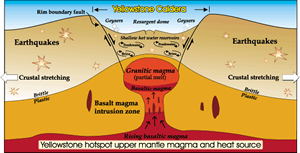Supervolcano
Volcano Learning zone > Volcano Glossary
 A supervolcano erupts are 1000 s of times larger than normal volcanoes. To be "super" a volcano has the potential to erupt a volume of material larger than 1000 km 3 or 240 cubic miles . They usually form over a hot spot or mantle plume lieing beneath continental crust. They often appear on the surface as a large depression called a caldera which can be 10 s of km across. The depression is sometimes filled with a lake as at Taupo in New Zealand. The caldera is formed as the magma inside is violently blown out of the magma chamber below. Initially this is from the edges then the whole caldera floor collapses, leaving a flat bottomed depression surrounded by steep sides.
A supervolcano erupts are 1000 s of times larger than normal volcanoes. To be "super" a volcano has the potential to erupt a volume of material larger than 1000 km 3 or 240 cubic miles . They usually form over a hot spot or mantle plume lieing beneath continental crust. They often appear on the surface as a large depression called a caldera which can be 10 s of km across. The depression is sometimes filled with a lake as at Taupo in New Zealand. The caldera is formed as the magma inside is violently blown out of the magma chamber below. Initially this is from the edges then the whole caldera floor collapses, leaving a flat bottomed depression surrounded by steep sides.
Yellowstone is a supervolcano beneath the North American continent. It roughly erupts every 600,000 years. The mantle plume beneath the plate above has remained stationary whilst the plate over the top has moved to the SW. The map shows the track of the Yellowstone hot spot.


